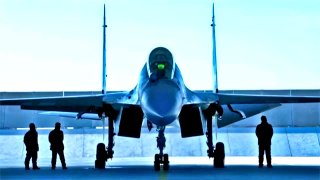China's J-16D Is an Electronic Warfare 'Nightmare' for the U.S. Navy
China's J-16D electronic warfare (EW) fighter jet, based on the J-16, aims to challenge U.S. air dominance, particularly against the EA-18G Growler.
Summary and What You Need to Know: China's J-16D electronic warfare (EW) fighter jet, based on the J-16, aims to challenge U.S. air dominance, particularly against the EA-18G Growler.
-The J-16D, equipped with jamming pods and an advanced electronic warfare system, could potentially disrupt U.S. and Taiwanese air defenses.
-While the jet's full capabilities remain unproven, its ability to jam AWACS systems and possibly interfere with U.S. Navy Aegis combat systems presents a serious threat.
-However, the U.S. would likely detect and neutralize the J-16D before it could cause significant damage, but Taiwan's defenses might be more vulnerable, raising concerns over China’s air superiority in the region.
J-16D Fighter Jet: Could China Challenge America’s EA-18G Growler?
For air supremacy in East Asia, China needs an electronic warfare fighter jet that can compete with the American EA-18G Growler. It appears the Chinese may have accomplished this goal. A few years back, pictures emerged from an air show in the southern China city of Zhuhai that showed jamming pods on the wings of the J-16D, pointing to the Chinese potentially achieving electronic warfare (EW) capabilities.
But Will This Lead To EW Dominance in the Air?
The J-16D is based on the J-16 warplane, which is itself derived from the Russian Su-27 Flanker.
The idea is to remove the nose-mounted infrared search and track radar system along with the 30-mm cannon on the J-16. Then replace them with an enhanced electronic warfare system and a scanned array radar.
The J-16D can also be outfitted with missiles and bombs giving it conventional warfighting capabilities.
Social media has already erupted with photos of what look to be four newfangled and distinct jamming pods under the wings and air inlets of the J-16D.
The pictures also show EW pods on the tips of its wings.
This may be comprised of mocked-up hardware signifying that the Chinese are just showing off a prototype that does not have the full capabilities of modern EW. But the J-16D did reportedly fly into Zhuhai for the air show, so it is airworthy
Disruption Capabilities of the J-16D Against U.S. and Taiwan Forces
Say the J-16D EW capabilities are already tested, proven, and operational. It would still need to be integrated with the Chinese Shaanxi KJ-500, which is the People’s Liberation Army Air Force’s (PLAAF) version of an American AWACS airplane for early warning and air battle traffic control.
It is not likely that the Chinese have made it this far. But the J-16D is a significant asset if the new EW capabilities are for real.
More problematic would be the capability of the J-16D jamming and deceiving an American AWACS airplane such as the E2-C Hawkeye. That would be a challenge that could lead to the potential anti-access/area denial (A2/AD) of the U.S. Navy in the Taiwan Strait or the South China Sea.
Moreover, Taiwan is endangered too. The J-16D could jam and spoof radar systems in Taiwan and allow for a decisive aerial bombing campaign against the Taiwanese. In fact, China has already threatened Taiwan in the air. Taiwan admitted that 24 Chinese warplanes entered its air defense identification zone on September 23rd.
Another capability that would spook the United States would be the jamming of the surface-to-air missile systems for the Navy’s Aegis combat system. This would give the PLAAF quite an advantage if the J-16D is able to conduct this type of EW.

The vaunted Aegis AN/SPY-1 radar could be vulnerable to spoofing from the J-16D. However, it is likely the Chinese airplane would be intercepted before it could wreak this kind of havoc. It is not clear what the maximum effective range of J-16D EW capabilities are.
China is not trying to hide the J-16D. After all, amateur photographers have already captured the new hardware on the airplane. So, it looks like the Chinese are confident and even engaging in braggadocio.
The prowess of the J-16D should not be overstated. The Americans would likely be able to identify and remove it from the battlespace before it could engage in meaningful EW. But Taiwan is a different story.
If the Taiwanese military became blinded and deaf with their radar spoofed and communications jammed, their response to a Chinese air attack would be greatly diminished. And that could be catastrophic if hostilities in the Taiwan Strait ensued.
About the Author: Dr. Brent M. Eastwood
Brent M. Eastwood, PhD, is the author of Humans, Machines, and Data: Future Trends in Warfare. He is an Emerging Threats expert and former U.S. Army Infantry officer.
All images are Creative Commons.


